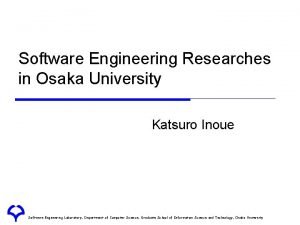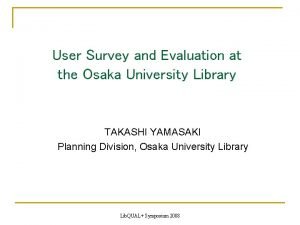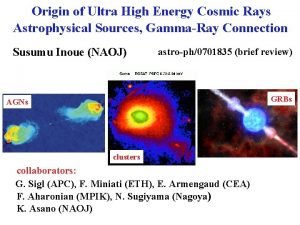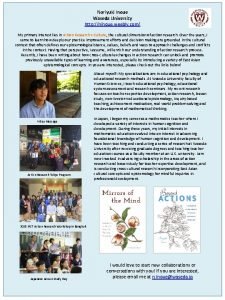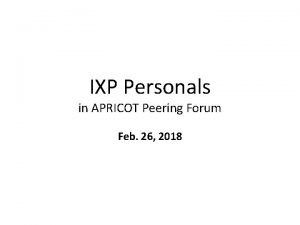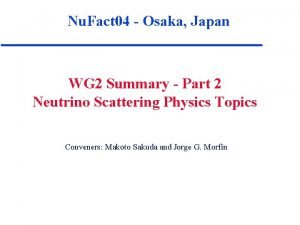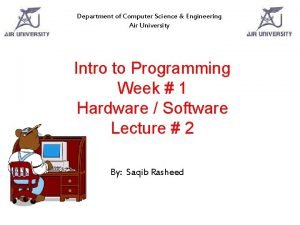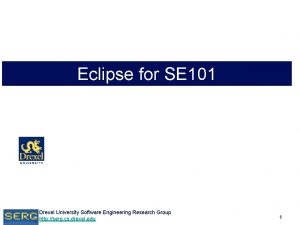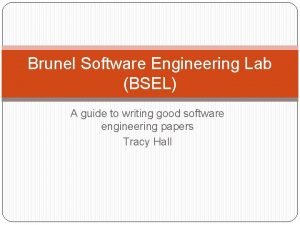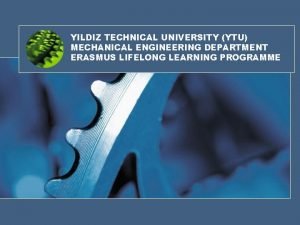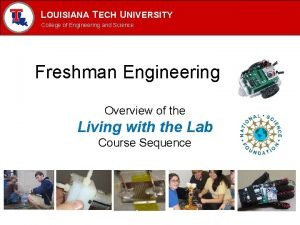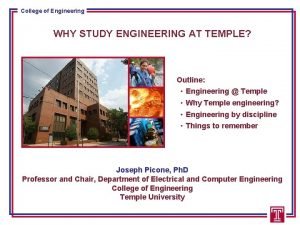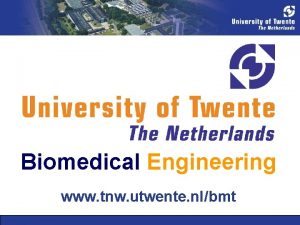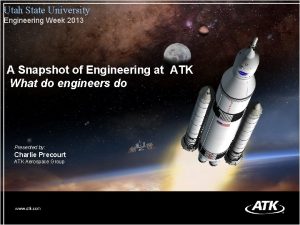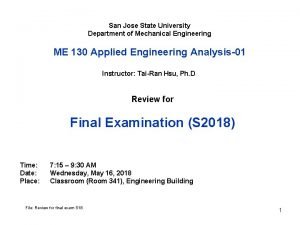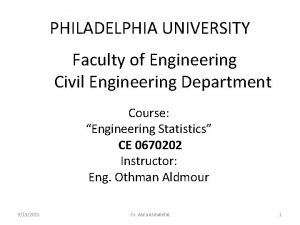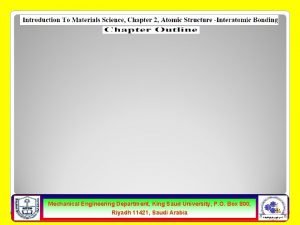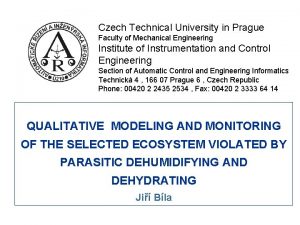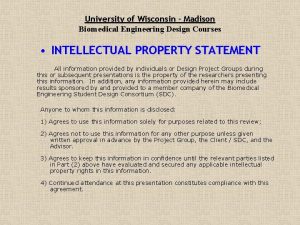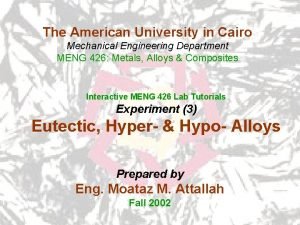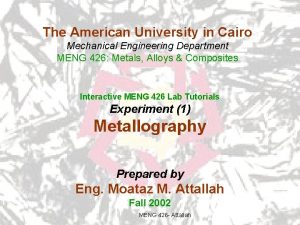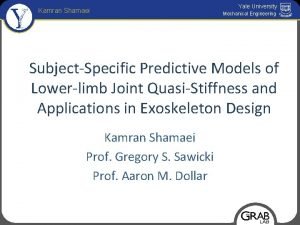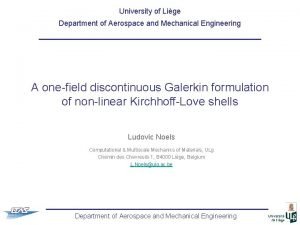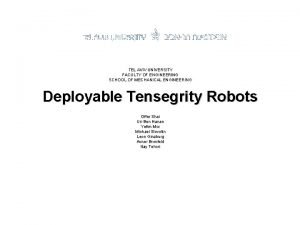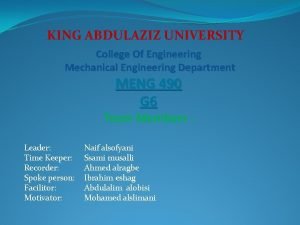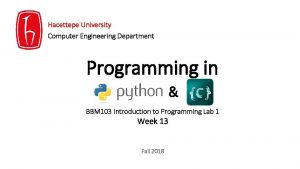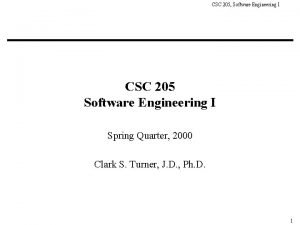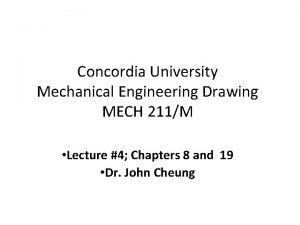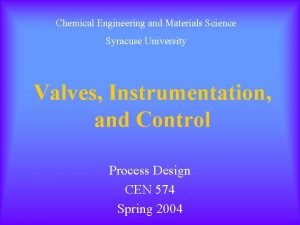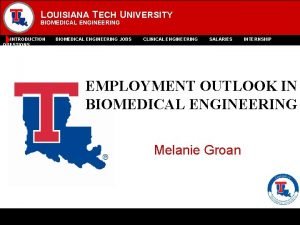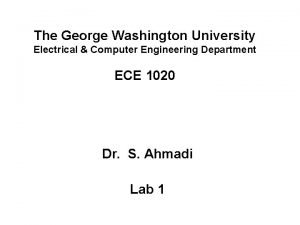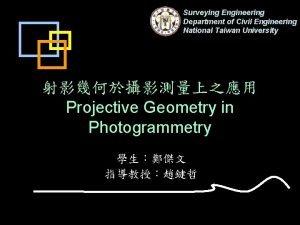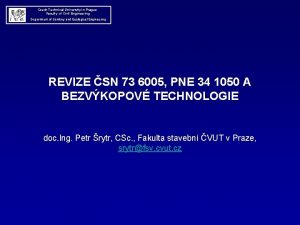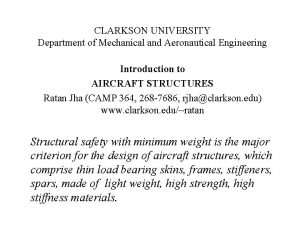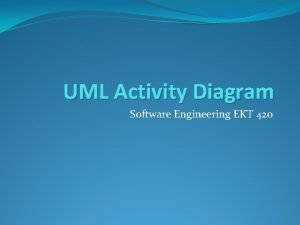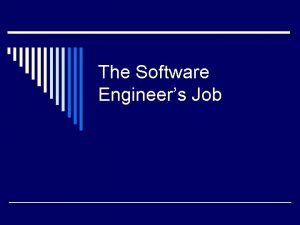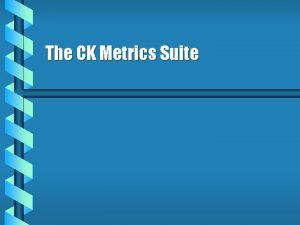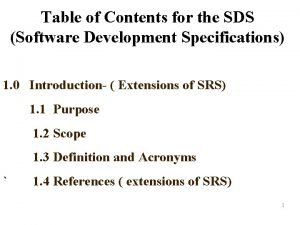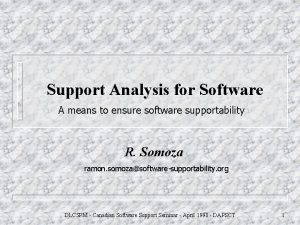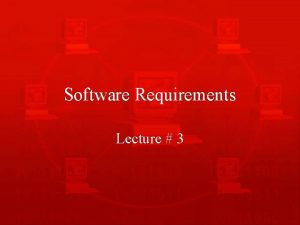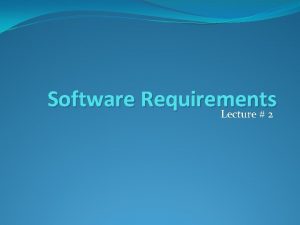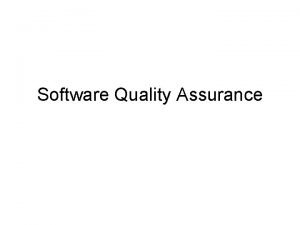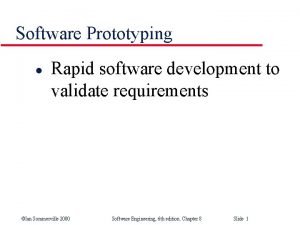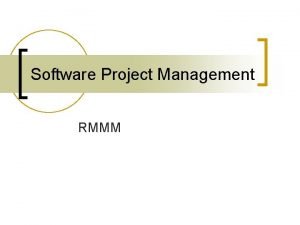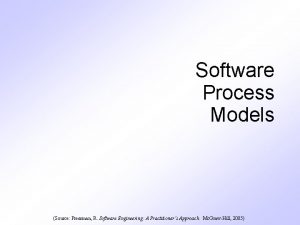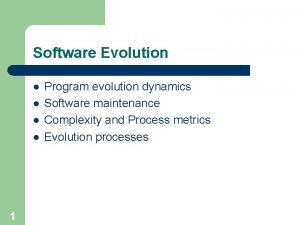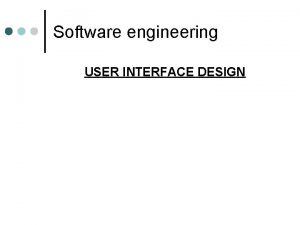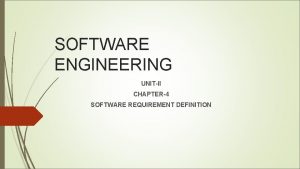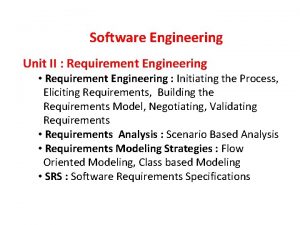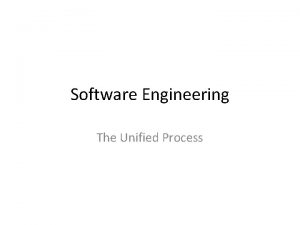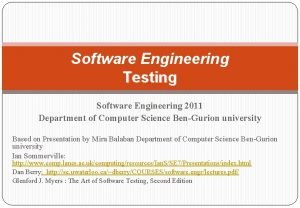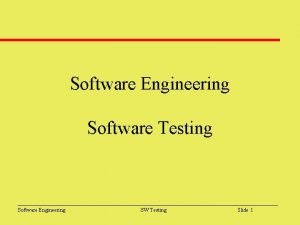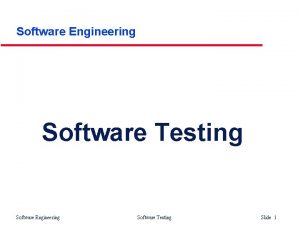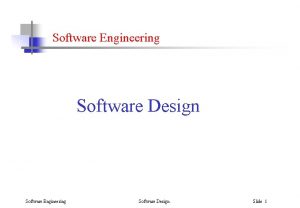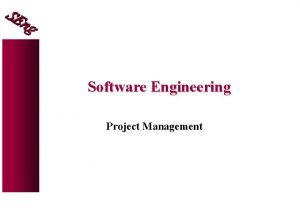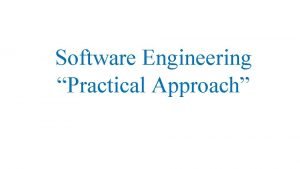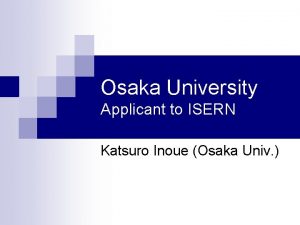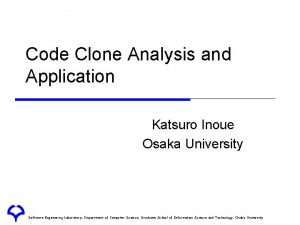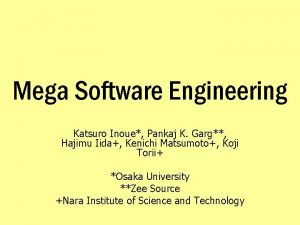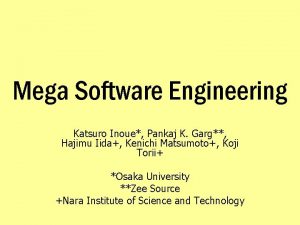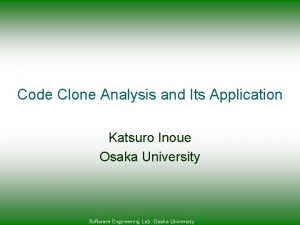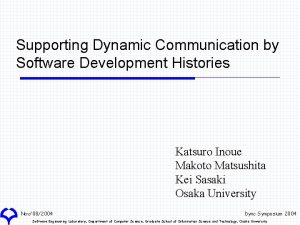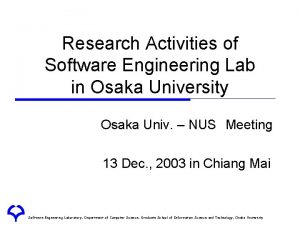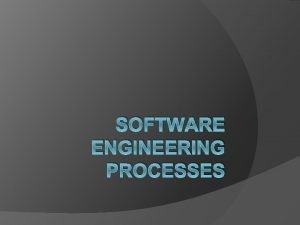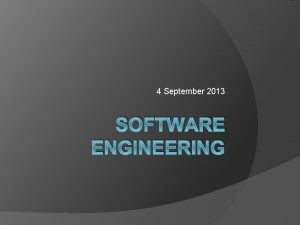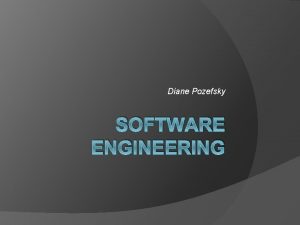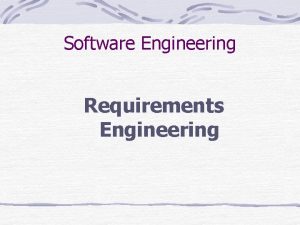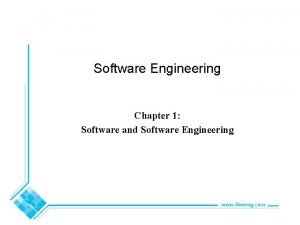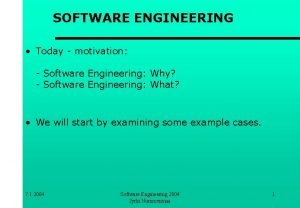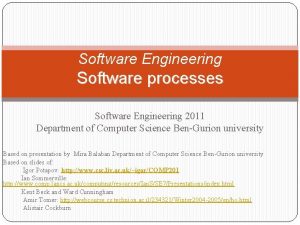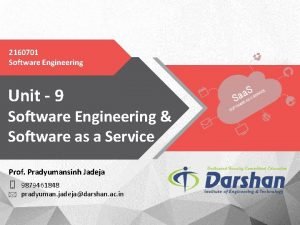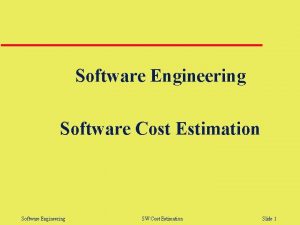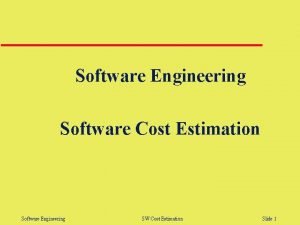Software Engineering Researches in Osaka University Katsuro Inoue


























![Detection tool: CCFinder Detection Process 1. 1. staticvoidfoo()throws. RESyntax. Exception{{ 2. 2. Stringa[] a[]==new Detection tool: CCFinder Detection Process 1. 1. staticvoidfoo()throws. RESyntax. Exception{{ 2. 2. Stringa[] a[]==new](https://slidetodoc.com/presentation_image_h/d6c19da7975699db81f4b5fd47ccee53/image-27.jpg)












































































- Slides: 103

Software Engineering Researches in Osaka University Katsuro Inoue Software Engineering Laboratory, Department of Computer Science, Graduate School of Information Science and Technology, Osaka University

28 th International Conference on Software Engineering Prof. Fuqing Yang Software Engineering Laboratory, Department of Computer Science, Graduate School of Information Science and Technology, Osaka University

Talk Structure • Overview of Osaka University and Software Engineering Lab • Code Clone Analysis and Application • Component Ranking based on Use Relation • Empirical Approach to Software Engineering Laboratory, Department of Computer Science, Graduate School of Information Science and Technology, Osaka University

Overview of Osaka University and Software Engineering Laboratory, Department of Computer Science, Graduate School of Information Science and Technology, Osaka University

Map of Japan Software Engineering Laboratory, Department of Computer Science, Graduate School of Information Science and Technology, Osaka University

Osaka University Osaka-u Software Engineering Laboratory, Department of Computer Science, Graduate School of Information Science and Technology, Osaka University

Osaka University • • 75 years history 14 schools 1000 million $ budget 2500 faculty members 13, 000 undergraduate students 7, 500 graduate students Computer related school – Graduate School of Information Science and Technology Software Engineering Laboratory, Department of Computer Science, Graduate School of Information Science and Technology, Osaka University

Graduate Courses Graduate School of Information Science and Technology – Pure and Applied Mathematics – Information and Physical Sciences – Computer Science – Information Systems Engineering – Information Networking – Multimedia Engineering – Bioinformatic Engineering about 250 master students, 100 Ph. D students Software Engineering Laboratory, Department of Computer Science, Graduate School of Information Science and Technology, Osaka University

Undergraduate Courses • School of Engineering Science – Department of Informatics and Mathematical Science about 350 students • School of Engineering – Department of Information Systems Engineering about 250 students Software Engineering Laboratory, Department of Computer Science, Graduate School of Information Science and Technology, Osaka University

Software Engineering Related Lab’s • 3 research groups, 8 faculty members – Software design and verification in formal approach – Dependable computing and reliability engineering – Software engineering in empirical approach (SE lab. ) • 2 faculty members in SE lab. – Inoue, K. Software Reuse, Program Analysis – Matsushita, M. Open Source, Software Environment • Students – – 2 post doc (1 foreigner, UK) 9 Ph. D. candidates (1 foreign student, Italy) 13 master students (2 foreign students, Malaysia) 4 undergraduate students Software Engineering Laboratory, Department of Computer Science, Graduate School of Information Science and Technology, Osaka University

Our Research Focus (1) • Software analysis Large scale and practical target – Code-clone detection – Component Ranking for software reuse – Alias analysis for object oriented language Software Engineering Laboratory, Department of Computer Science, Graduate School of Information Science and Technology, Osaka University

Our Research Focus (2) • Empirical Software Engineering Large scale measurement – Real-time data collection and analysis – Function point analysis – Object oriented program measurement Software Engineering Laboratory, Department of Computer Science, Graduate School of Information Science and Technology, Osaka University

Our Research Focus (3) • Software Development Environment Practically used tools – Open source – Versioning system Software Engineering Laboratory, Department of Computer Science, Graduate School of Information Science and Technology, Osaka University

University Hospital Model Collaboration in medical human resource new ideas research fund practical data evaluation skill University patients residents money cure new knowledge expert development Univ. Hospital Society Software Engineering Laboratory, Department of Computer Science, Graduate School of Information Science and Technology, Osaka University

Software Engineering Lab. University-industry collaboration model for Software Engineering human resources new idea human resource practical problems fund practical evaluation fund new theme solution know human development University Soft. Eng. Lab. Industry Software Engineering Laboratory, Department of Computer Science, Graduate School of Information Science and Technology, Osaka University

Collaboration and Funding • EASE (Empirical Approach to Software Engineering) – MEXT (Ministry of Education, Culture, Sports, Science and Technology) • Code-Clone Analysis – MEXT – Software Engineering Center, Japan • Mega Software Engineering – MEXT • Software Maintenance Effort Estimation – Fujitsu Lab. • Model-Driven Architecture – NTT Data • XML-Based Domain Modeling – Hitachi Software Engineering Laboratory, Department of Computer Science, Graduate School of Information Science and Technology, Osaka University

SE Education Program 1. Engineering Basis 2. Creative Design 3. Project Management Software Architect Software Engineering Laboratory, Department of Computer Science, Graduate School of Information Science and Technology, Osaka University

Talk Structure • Overview of Osaka University and Software Engineering Lab • Code Clone Analysis and Application • Component Ranking based on Use Relation • Empirical Approach to Software Engineering Laboratory, Department of Computer Science, Graduate School of Information Science and Technology, Osaka University

Code Clone Analysis and Application Software Engineering Laboratory, Department of Computer Science, Graduate School of Information Science and Technology, Osaka University

Clone Detection Software Engineering Laboratory, Department of Computer Science, Graduate School of Information Science and Technology, Osaka University

What is Code Clone? • A code fragment which has identical or similar code fragments in source code • Introduced in source code because of various reasons code clone copy-and-paste – code reuse by `copy-and-paste’ – stereotyped function • ex. file open,DB connect, … – intentional iteration • performance enhancement • Makes software maintenance more difficult – If we modify a code clone with many similar code fragments, it is necessary to consider whether or not we have to modify each of them • It is likely to overlook some of them Software Engineering Laboratory, Department of Computer Science, Graduate School of Information Science and Technology, Osaka University

Definition of Code Clone • No single or generic definition of code clone – • So far, several methods of code clone detection have been proposed, and each of them has its own definition about code clone Various detection methods 1. 2. 3. 4. 5. Line-based comparison AST (Abstract Syntax Tree) based comparison PDG(Program Dependency Graph) based comparison Metrics comparison Token-based comparison Software Engineering Laboratory, Department of Computer Science, Graduate School of Information Science and Technology, Osaka University

CCFinder and Associate Tools Software Engineering Laboratory, Department of Computer Science, Graduate School of Information Science and Technology, Osaka University

Clone Pair and Clone Set • Clone Pair – a pair of identical or similar code fragments • Clone Set – a set of identical or similar fragments C 1 C 2 C 3 C 4 C 5 Clone Pair Clone Set (C 1, C 2) {C 1, C 2, C 4} (C 1, C 4) {C 3, C 5} (C 2, C 4) (C 3, C 5) Software Engineering Laboratory, Department of Computer Science, Graduate School of Information Science and Technology, Osaka University

Our Code Clone Research • Develop tools – – Detection tool: CCFinder Visualization tool: Gemini Refactoring support tool: Aries Debug support tool: Libra • Deliver our tools to domestic or overseas organizations/individuals – More than 100 companies uses our tools! • Promote academic-industrial collaboration – Organize code clone seminars – Manage mailing-lists Software Engineering Laboratory, Department of Computer Science, Graduate School of Information Science and Technology, Osaka University

Detection tool: Development of CCFinder • Developed by industry requirement – Maintenance of a huge system • More than 10 M LOC, more than 20 years old • Maintenance of code clones by hand had been performed, but. . . • Token-base clone detection tool CCFinder – – – Normalization of name space Parameterization of user-defined names Removal of table initialization Identification of module delimiter Suffix-tree algorithm • CCFinder can analyze the system of millions line scale in 5 -30 min. Software Engineering Laboratory, Department of Computer Science, Graduate School of Information Science and Technology, Osaka University
![Detection tool CCFinder Detection Process 1 1 staticvoidfoothrows RESyntax Exception 2 2 Stringa anew Detection tool: CCFinder Detection Process 1. 1. staticvoidfoo()throws. RESyntax. Exception{{ 2. 2. Stringa[] a[]==new](https://slidetodoc.com/presentation_image_h/d6c19da7975699db81f4b5fd47ccee53/image-27.jpg)
Detection tool: CCFinder Detection Process 1. 1. staticvoidfoo()throws. RESyntax. Exception{{ 2. 2. Stringa[] a[]==new new. String[][]{{"123, 400", "abc", "orange 100"}; }; 3. 3. org. apache. regexp. REpat pat==new neworg. apache. regexp. RE("[0 -9, ]+"); 4. 4. intsum sum==0; 0; 5. 5. for(intii==0; 0; ii<<a. length; ++i) 6. 6. ifif(pat. match(a[i])) 7. 7. sum+= +=Sample. parse. Number(pat. get. Paren(0)); 8. 8. System. out. println("sum==""++sum); 9. 9. }} 10. staticvoidgoo(String[][]a)a)throws. RESyntax. Exception{{ 11. RE REexp exp==new new. RE("[0 -9, ]+"); 12. intsum sum==0; 0; 13. for(intii==0; 0; ii<<a. length; ++i) 14. ifif(exp. match(a[i])) 15. sum+= +=parse. Number(exp. get. Paren(0)); 16. System. out. println("sum==""++sum); 17. }} Source files Lexicalanalysis Lexical analysis Tokensequence Token sequence Transformation Transformedtokensequence Transformed token sequence Matchdetection Match detection Cloneson ontransformedsequence Clones on transformed sequence Formatting Clone pairs Software Engineering Laboratory, Department of Computer Science, Graduate School of Information Science and Technology, Osaka University

Visualization Tool: Gemini Outline • Visualizes code clones detected by CCFinder – CCFinder outputs the detection result to a text file • Providesinteractive analyses of code clones – Scatter Plot – Clone metrics – File metrics • Filters out unimportant code clones Software Engineering Laboratory, Department of Computer Science, Graduate School of Information Science and Technology, Osaka University

Visualization tool: Gemini Scatter Plot D 1 F 1 D 2 F 3 F 4 a b c c c a b d e f a b c c d e f F 2 F 3 D 2 F 4 a b c c c a b d e f a b c c d e f F 1 D 1 • Visually shows where code clones are • Both the vertical and horizontal axes represent the token sequence of source code – The original point is the upper left corner • means that corresponding two tokens on the two axes are the same – Symmetric to diagonal (show only low below) – is an element of practical code clone – is an element of noninteresting code clone F 1, F 2, F 3, F 4 : files D 1, D 2 : directories : matched position detected as a practical code clone : matched position detected as a non -interesting code clone Software Engineering Laboratory, Department of Computer Science, Graduate School of Information Science and Technology, Osaka University

Visualization tool: Gemini Clone Metrics,File Metrics • Metrics are used to quantitatively characterize entities • Clone metrics – LEN(S): the average length of code fragments (the number of tokens) in clone set S – POP(S): the number of code fragments in S – NIF(S): the number of source files including any fragments of S – RNR(S): the ratio of non-repeated code sequence in S • File metrics – ROC(F): the ratio of duplication of file F • if completely duplicated, the value is 1. 0 • if not duplicated at all, the value is 0, 0 – NOC(F): the number of code fragments of any clone set in file F – NOF(F): the number of files sharing any code clones with file F Software Engineering Laboratory, Department of Computer Science, Graduate School of Information Science and Technology, Osaka University

Applications Software Engineering Laboratory, Department of Computer Science, Graduate School of Information Science and Technology, Osaka University

Academic-industrial collaboration: Code Clone Seminar • We have organized code seminars 6 times – From Dec 2002 • Seminar is the place where we exchange views with industrial people • Contents of Seminar – Tools demonstration – Lecture of how to use code clone information – Case report of companies using our tools Software Engineering Laboratory, Department of Computer Science, Graduate School of Information Science and Technology, Osaka University

Case Studies • Open source software – Free. BSD, Net. BSD, Linux(C, 7 MLOC) – JDK Libraries(Java 1. 8 MLOC) – Qt(C++, 240 KLOC) • Commercial software(more than 100 companies) – IPA/SEC, NTT Data Corp. , Hitachi Ltd. , Hitachi GP, Hitachi SAS, NEC soft Ltd. , ASTEC Inc. , SRA Inc. , JAXA, Daiwa Computer, etc… • Students excise of Osaka University • Filed in a court as an evidence for software copyright suit Software Engineering Laboratory, Department of Computer Science, Graduate School of Information Science and Technology, Osaka University

Case study 1: Similarity between Free. BSD, Net. BSD, Linux • Result – There are many code clones between Free. BSD and Net. BSD – There a little code clones between Linux and Free. BSD/Net. BSD • Their Histories can explain the result – The ancestors of Free. BSD and Net. BSD are the same – Linux was made from scratch Software Engineering Laboratory, Department of Computer Science, Graduate School of Information Science and Technology, Osaka University

Case study 2: Students Excise • Target – Programs developed in a programming exercise of Osaka Univ. • • • Simple compiler for Pascal written in C language Programs of 5 students This exercise consists of 3 steps – – – • STEP 1: makes a syntax checker STEP 2: makes a semantics checker by extending his/her syntax checker STEP 3: makes a total compiler by extending his/her semantic checker Purpose – Similarity among students • In programming exercise, plagiarisms sometimes happen Software Engineering Laboratory, Department of Computer Science, Graduate School of Information Science and Technology, Osaka University

Result • • There were a lot of code clones between S 2 and S 5 We did not use the detection result for evaluating their excises S 1 S 2 S 3 S 4 S 5 Software Engineering Laboratory, Department of Computer Science, Graduate School of Information Science and Technology, Osaka University

Case study 3: IPA/SEC Advanced Project • Target – A probe information system developed by 5 Japanese companies – The project manager didn’t know states of the source code because the companies individually developed the components • Purpose – Grasp features of black-boxed source code • Others – Applied twice times, after unit test (280, 000 LOC), after combined test(300, 000 LOC) – The minimum size of detected code clone is 30 tokens Software Engineering Laboratory, Department of Computer Science, Graduate School of Information Science and Technology, Osaka University

IPA/SEC Advanced Project: Duplicated Ratio • The below graph illustrates the transition of duplicated ratio of the sub-system developed by a company • We interviewed developers of the sub-system – They added library code managed in their company to the system to add new functions right before combined test – Reliability of the library code is high because it have been maintained for a long time Software Engineering Laboratory, Department of Computer Science, Graduate School of Information Science and Technology, Osaka University

IPA/SEC Advanced Project: Scatter Plot Analysis • Scatter Plot of company X • In part A, there are many noninteresting code clones – output code for debug (consecutive printf-statements) – check data validity – consecutive if-statements • In part B, there are many code clones across directories – This part treats vehicle position information – Each directory include a single kind of vehicles, e. g. , taxi, bus, or track – Logics are mostly the same Software Engineering Laboratory, Department of Computer Science, Graduate School of Information Science and Technology, Osaka University

Summary of Code Clone Analysis and Application Software Engineering Laboratory, Department of Computer Science, Graduate School of Information Science and Technology, Osaka University

Conclusion • We have developed Code clone analysis tools – Detection tool: CCFinder – Visualization tool: Gemini – Refactoring support tool: Aries – Debug support tool: Libra • We have promoted academic-industrial collaboration – organize code clone seminars – manage mailing lists • We have applied our tools to various software Software Engineering Laboratory, Department of Computer Science, Graduate School of Information Science and Technology, Osaka University

Future Direction • CCFinder. X – Token analyzer is definable • Architecture evolution by the view of code clones • System analysis via code clones associated with other metrics Software Engineering Laboratory, Department of Computer Science, Graduate School of Information Science and Technology, Osaka University

Resources • Papers T. Kamiya, S. Kusumoto, and K. Inoue, CCFinder: A multi-linguistic token-based code clone detection system for large scale source code, IEEE Transactions on Software Engineering, vol. 28, no. 7, pp. 654 -670, Jul. 2002. Many Others. . . See our home page • Web – CCFinder: http: //sel. ist. osaka-u. ac. jp/cdtools/index-e. html – CCFinder. X: http: //www. ccfinder. net/ccfinderx. html • Tools – See home pages Software Engineering Laboratory, Department of Computer Science, Graduate School of Information Science and Technology, Osaka University

Talk Structure • Overview of Osaka University and Software Engineering Lab • Code Clone Analysis and Application • Component Ranking based on Use Relation • Empirical Approach to Software Engineering Laboratory, Department of Computer Science, Graduate School of Information Science and Technology, Osaka University

Component Rank Based on Use Relation Software Engineering Laboratory, Department of Computer Science, Graduate School of Information Science and Technology, Osaka University

Source. Forge • Large open source software development web site • Version control, communication support, . . . Hosted Projects: Registered Users: 121, 208 1, 322, 774 Software Engineering Laboratory, Department of Computer Science, Graduate School of Information Science and Technology, Osaka University

Motivation • Numerous software systems are being developed day by day • Similar components (libraries, portions of codes, or abstracted algorithms, . . . ) might be independently developed in different projects • Reuse: – Key factor for high productivity and reliability in today’s software development • Large software libraries: – Little support to search components effectively – Managing structure and consistency is very difficult and impractical Software Engineering Laboratory, Department of Computer Science, Graduate School of Information Science and Technology, Osaka University

Automated Component Library • Collect software components eagerly without preserving their inherent structures • Analyze relations among components by using various analysis techniques • Rank the components based on their Component Rank Model significance • Answer user’s queries according to the rank Software Engineering Laboratory, Department of Computer Science, Graduate School of Information Science and Technology, Osaka University

Component Graph System Y System X A B F C D G E H I component use relation Software Engineering Laboratory, Department of Computer Science, Graduate School of Information Science and Technology, Osaka University

Weight of Nodes System Y System X 0. 1 A B C 0. 1 D 0. 1 0. 2 E 0. 1 0. 05 H F 0. 1 G 0. 2 I 0. 05 sum of all node weights = 1. . . (1) weight of node represents significance of node Software Engineering Laboratory, Department of Computer Science, Graduate School of Information Science and Technology, Osaka University

Weights of Edges 0. 05 0. 2 d=1/4 0. 2 A d=1/4 0. 05 d=1/4 0. 05 B 0. 4 0. 15 d: distribution ratio w(A) = sum of all outgoing edge weights sum of all incoming edge weights = w(B) . . . (2). . . (3) Software Engineering Laboratory, Department of Computer Science, Graduate School of Information Science and Technology, Osaka University

Definition of Weights • Under constraints (1)~(3), we have a simultaneous equation = W: node weight vector . Dt: transposed matrix of distribution ratio Software Engineering Laboratory, Department of Computer Science, Graduate School of Information Science and Technology, Osaka University

Propagating Weights 0. 34 0. 17 A 0. 33 B 0. 17 0. 33 C Software Engineering Laboratory, Department of Computer Science, Graduate School of Information Science and Technology, Osaka University

Propagating Weights 0. 33 0. 175 A 0. 17 B 0. 175 0. 17 0. 5 C Software Engineering Laboratory, Department of Computer Science, Graduate School of Information Science and Technology, Osaka University

Propagating Weights 0. 5 0. 25 A 0. 175 B 0. 25 0. 345 0. 175 0. 345 C Software Engineering Laboratory, Department of Computer Science, Graduate School of Information Science and Technology, Osaka University

Propagating Weights 0. 4 0. 2 A B 0. 2 0. 4 C Stable weight assignment (eigenvector computation) Component Rank : order of nodes sorted by the weight Software Engineering Laboratory, Department of Computer Science, Graduate School of Information Science and Technology, Osaka University

Markov Model 0. 02 0. 01 0. 05 0. 03 0. 001 0. 1 • Component rank model can be considered as a Markov Chain of user's focus • User's focus moves from one component to another along a use relation at a fixed time period • Node weight represents the existence probability of the user's focus Software Engineering Laboratory, Department of Computer Science, Graduate School of Information Science and Technology, Osaka University

Clustering Components C G B F A D component graph C G BF E AD E clustered component graph Software Engineering Laboratory, Department of Computer Science, Graduate School of Information Science and Technology, Osaka University

SPARS-J: Component Rank System input similarity measure by SMMT . java file = component similarity criterion t: sharing 80% statements output componentrank pairs use relation extraction • inheritance • method call • attribute access • abstract class impl. clustered graph clustering construction weight ratio p between real and pseudo edges : 0. 85 de-clustering to original graph node weight computation equal distribution ratio d to outgoing edges Software Engineering Laboratory, Department of Computer Science, Graduate School of Information Science and Technology, Osaka University

Experiment 1 JDK 1. 3. 0 575, 000 lines, 1877 components 7 minutes on PC (Pentium IV, 2 GHz, 2 GB) rank class name 1 java. lang. Object 2 java. lang. Class 3 java. lang. Throwable 4 java. lang. Exception 5 java. io. IOException 6 java. lang. String. Buffer 7 java. lang. Security. Manager 8 java. io. Input. Stream 9 java. lang. reflect. Field 10 java. lang. reflect. Constructor. . . 1256 sunw. util. Event. Listener. . . 1256 weight 0. 16126 0. 08712 0. 05510 0. 03103 0. 01343 0. 01214 0. 01169 0. 01027 0. 00948 0. 00936. . . 0. 00011. . . Software Engineering Laboratory, Department of Computer Science, Graduate School of Information Science and Technology, Osaka University

Experiment 2: Collection of SE Tools and Libraries – CK metrics measurement tools, component rank system – ANTLR, JAMA, Caffe Cappuccino – 582 components rank class name 1 antlr. Token 2 antlr. debug. Event 2 antlr. debug. New. Line. Event 4 antlr. collections. impl. Vector 5 jp. gr. java_conf. keisuken. text. html. Html. Parameter 6 jp. gr. java_conf. keisuken. net. server. Server. Properties 7 Jama. Matrix 8 jp. gr. java_conf. keisuken. util. Integer. Array 8 jp. gr. java_conf. keisuken. util. Long. Array 10 jp. ac. osaka_u. es. ics. iip_lab. metrics. parser. Identifier. Info. . . 418 cktool_new. examples. Main weight 0. 10727 0. 06189 0. 05434 0. 05246 0. 03699 0. 01564 0. 01390 0. 01365. . . 0. 00050 Software Engineering Laboratory, Department of Computer Science, Graduate School of Information Science and Technology, Osaka University

Experiment 3: Application to Industry • Daiwa computer: a middle size software company in Osaka • A shared Java application framework for web-based data management • 5 applications + framework – 1538 components, 339 clustered nodes • Classes in the framework and definitions of data structure are highly ranked Software Engineering Laboratory, Department of Computer Science, Graduate School of Information Science and Technology, Osaka University

Related Works • Markov models of documentation traversal – Influence Weight: impact of publication thought references – Page Rank: weight of HTML in the Internet through web links Explicit use relation No clustering (important for software products) • Reusability measurement – Various characteristic metrics of components or interfaces Indirect inference of reusability (our approach directly reflects usage of components) Software Engineering Laboratory, Department of Computer Science, Graduate School of Information Science and Technology, Osaka University

Software Engineering Laboratory, Department of Computer Science, Graduate School of Information Science and Technology, Osaka University



Conclusion & Future Work • Component Rank: a novel model for software component • SPARS-J for Java • Application to various collections of Java programs • Application to Companies • Other model (weight distribution, similarity, . . . ) Software Engineering Laboratory, Department of Computer Science, Graduate School of Information Science and Technology, Osaka University

Resources • Papers – Component Rank: Relative Significance Rank for Software Component Search Proceedings of the 25 th International Conference on Software Engineering (ICSE 2003), pp 14 -24, Portland, Oregon, U. S. A. , May 6 -8, 2003. – Ranking Significance of Software Components Based on Use Relations IEEE Transactions on Software Engineering, Vol. 31, No. 3, pp. 213 -225 • SPARS-J Demo WEB site (about 200, 000 Java classes) http: //www. spars. info Software Engineering Laboratory, Department of Computer Science, Graduate School of Information Science and Technology, Osaka University

Talk Structure • Overview of Osaka University and Software Engineering Lab • Code Clone Analysis and Application • Component Ranking based on Use Relation • Empirical Approach to Software Engineering Laboratory, Department of Computer Science, Graduate School of Information Science and Technology, Osaka University

Empirical Approach to Software Engineering Laboratory, Department of Computer Science, Graduate School of Information Science and Technology, Osaka University

Software Development with Scientific Background • Many other science and technology fields use an approach: – Measure -> Quantify – Evaluation based on the quantification – Feedback for improvement • How about software engineering field? Software Engineering Laboratory, Department of Computer Science, Graduate School of Information Science and Technology, Osaka University

Current Situation on Software Engineering • Many many software engineering methods, tools and techniques had been proposed for 30 years. • Are they really useful? • No real evaluation for them – Evaluation is generally very expensive • Evaluation by history (ICSE n-10) Software Engineering Laboratory, Department of Computer Science, Graduate School of Information Science and Technology, Osaka University

Empirical Software Engineering • Quantitative evaluation of various methods, tools, and techniques on software engineering • Limitation of university • Data collection from industry is essential – Collaboration with industry Software Engineering Laboratory, Department of Computer Science, Graduate School of Information Science and Technology, Osaka University

Journal by Kluwer Empirical Software Engineering • Scope – Cost estimation techniques – Analysis of the effects of design methods and characteristics – Evaluation of testing methodologies – Development of predictive models of defect rates and reliability from real data – Infrastructure issues, such as measurement theory, experimental design, qualitative modeling and analysis approaches. … Software Engineering Laboratory, Department of Computer Science, Graduate School of Information Science and Technology, Osaka University

International Symposium on Empirical Software Engineering ISESE 2002 @ Nara, Japan ISESE 2003 @ Roma, Italy ISESE 2004 @ California, USA ISESE 2005 @ Noosa Heads, AU ISESE 2006 @ Rio de Janeiro, Brazil Sep 21 -22, 2006 Software Engineering Laboratory, Department of Computer Science, Graduate School of Information Science and Technology, Osaka University

International Software Engineering Research Network ISERN • ISERN is a community that believes software engineering research needs to be performed in an experimental context. • ISERN was established in 1993 by researchers of software engineering from 12 countries, including USA, Germany, Australia, Italy, Finland Japan. • ISERN provides several means of communication between members; – Electronic Communication, – Annual meetings, and – Exchange of researchers. Software Engineering Laboratory, Department of Computer Science, Graduate School of Information Science and Technology, Osaka University

The EASE Project Software Engineering Laboratory, Department of Computer Science, Graduate School of Information Science and Technology, Osaka University

What Is the EASE Project? • Empirical Approach to Software Engineering • One of the leading projects of the Ministry of Education, Culture, Sports, Science and Technology (MEXT). • 5 year project starting in 2003. • Budget: about $1 million US / year. • Project leader: Koji Torii, NAIST Sub-leader: Katsuro Inoue, Osaka University Kenichi Matsumoto, NAIST http: //www. empirical. jp/English/ Software Engineering Laboratory, Department of Computer Science, Graduate School of Information Science and Technology, Osaka University

The Purpose of the EASE Project • Achievement of software development technology based on quantitative data – Construction of a quantitative data collection system • Result 1: Making of EPM open source – Construction of a system that supports development based on analyzed data • Result 2: EPM application experience • Result 3: Coordinated cooperation with SEC • Spread and promotion of software development technology based on quantitative data to industry sites • Result 4: Activation of the industrial world Software Engineering Laboratory, Department of Computer Science, Graduate School of Information Science and Technology, Osaka University

Empirical Activities in EASE • Data collection in real time, e. g. – configuration management history – issue tracking history – e-mail communication history Data Collection • Analysis with software tools, e. g. – – metrics measurement project categorization collaborative filtering software component retrieval Data Analysis Feedback • Feedback to stakeholders for improvement, e. g. – observations and rules – experiences and instances in previous projects Software Engineering Laboratory, Department of Computer Science, Graduate School of Information Science and Technology, Osaka University

The EASE Roadmap Social impact Effectiveness Data collection Software Development With High Reliability and Productivity Upstream Product Data Production Data analysis Project Plan Data Suggestions. Feedback Data Sharing Estimation Communication Alternatives Data Exception Analysis Industry Level Sharing Related Cases Quality Data Characterization Analysis Sharing Between Organizations Results Downstream Product Data Sharing Between Projects Collected data Sharing Between Developers 2003/4 2004/4 2005/4 2006/4 2007/4 2008/3 Software Engineering Laboratory, Department of Computer Science, Graduate School of Information Science and Technology, Osaka University

EPM: the Empirical Project Monitor Software Engineering Laboratory, Department of Computer Science, Graduate School of Information Science and Technology, Osaka University

EPM The Empirical Project Monitor • An application supporting empirical software engineering • EPM automatically collects development data accumulated in development tools through everyday development activities – Configuration management system: CVS – Issue tracking systems: GNATS – Mailing list managers: Mailman, Majordomo, FML Software Engineering Laboratory, Department of Computer Science, Graduate School of Information Science and Technology, Osaka University

Architecture Code clone detection GQM Component search (SPARS) Product data archive (CVS format) Developers Source Share GUI Managers Metrics measurement Logical Coupling Collaborative filtering Process data archive (XML format) Format Translator Versioning (CVS) Mailing (Mailman) Project x Project y Project z . . . Format Translator Issue tracking (GNATS) Format Translator Other tool data

Implementation Co-existing tools Code clone detection Plug-in Component search Metrics measurement Product data archive (CVS format) Developers Source Share GUI Managers Co-existing tools Logical Coupling Collaborative filtering Process data archive (XML format) Format Translator Versioning (CVS) Mailing (Mailman) Format Translator Core EPM Project x Project y Project z . . . Issue tracking (GNATS) Format Translator Other tool data

Automated Data Collection in EPM • Reduces the reporting burden on developers – without additional work for developers • Reduces the project information delay – data available in real time • Avoids mistakes and estimation errors – uses real (quantitative) data Software Engineering Laboratory, Department of Computer Science, Graduate School of Information Science and Technology, Osaka University

EPM’s GUI

An Example of Output • EPM can put data collected by CVS, Mailman, and GNATS together into one graph. Time stamp of program code check-in to CVS Time stamp of issue occurrence Cumulative number of mails exchanged among developers Time stamp of issue fixing Software Engineering Laboratory, Department of Computer Science, Graduate School of Information Science and Technology, Osaka University

Merits to Introducing EPM • Easy monitoring of projects in cooperation with the existing development environment. • Easy accumulation of the knowledge and experience of projects. • Collection and sharing of uniform data for projects in real time. • Sharing and reuse of information enabled through empirical data. Software Engineering Laboratory, Department of Computer Science, Graduate School of Information Science and Technology, Osaka University

Data Analysis with EPM Software Engineering Laboratory, Department of Computer Science, Graduate School of Information Science and Technology, Osaka University

How can we use so much data? Software Engineering Laboratory, Department of Computer Science, Graduate School of Information Science and Technology, Osaka University

Analysis Technologies and Models • Code clone analysis (CCfinder) • Collection, analysis, and search engine of software products (SPARS: Software Product Archive, analysis, and Retrieval System) • Collaborative filtering • Logical coupling • GQM (Goal/Question/Metric) model Software Engineering Laboratory, Department of Computer Science, Graduate School of Information Science and Technology, Osaka University

Analysis Targets Manager support Estimation of requirements for redesign caused by connections in the system structure Making similarity visible Class and utility evaluation of information related to use of methods Collection, analysis, and search engine of software products (SPARS) Code clone analysis The project management models for trouble evaluation Estimate of effort to correct based on file scale, number of accumulated defects, and defect type Evaluation of clone distribution Developer support Evaluation of component ranking Expert identification Grasp of the situation Collaborative filtering Logical coupling GQM (Goal/Question/Metric) Model The project delay risk detection model Distinction of modules (file) with high defect rates Abnormal detection ID candidates for refactoring Forecast Advice Software Engineering Laboratory, Department of Computer Science, Graduate School of Information Science and Technology, Osaka University

Applying EPM in Industries • EPM is being applied to several real projects – Business systems (Hitachi GP, Ltd. ) – Personal mobile applications (Mitsubishi Space Software Co. , Ltd. ) – Automobile information systems (SEC collaborative project)… • Very low additional effort by developers for data collection • Collected data is currently under analysis – Many findings only from collected data such as • Module refactoring candidates • Internal trouble detection Software Engineering Laboratory, Department of Computer Science, Graduate School of Information Science and Technology, Osaka University

Collaboration between EASE and SEC The Ministry of Education, Culture, Sports, Science and Technology Informationtechnology Promotion Agency, JAPAN Development of data collection system (EPM) Automated data collection system for use in industry EASE project 1000 project data Development of probe information platform Software engineering technique Software Engineering Center Development support Industrial development data Analysis result Analysis of data Consortium for Software Engineering Analysis of data 7 major automotive and IT companies Execution of proof experiments (Data collection and analysis result feedback)

EPM Application Experience Collaborating Enterprises Hitachi GP, Ltd. Mitsubishi Space Software Co. , Ltd. Software for application Package software for business in municipality agency Software purchased by a certain enterprise Development language Java, others Development period 6 months 10 months Development scale 130, 000 Loc 250, 000 Loc EPM introduction and operation cost 25 man-days 11 man-days EPM subjective evaluation by developers The automated data collection is useful. The presentation method of the analysis result is a useful means to see software and the development process objectively. The data collection doesn't disturb the development. The project transitions can be objectively understood from the collected data. Software Engineering Laboratory, Department of Computer Science, Graduate School of Information Science and Technology, Osaka University

Making of EPM Open Source • Japanese version in June, 2005 – Downloaded about 300 so far • English version in August, 2005 • License – Empirical Project Monitor License (EPML) that fixed the special contract articles to Common Public License (CPL) was made. – The user selects either CPL or EPML. CPL License regulations of U. S. IBM made based on IBM Public License. When software that combines the source code of CPL with the source code of original development is made, and the object code is distributed, it has to open only the part of the source code of CPL to the public. EPML: Special contract of articles The modification code need not be opened to the public, and be delivered to the project member the distribution ahead when the change to EPM and the source code (modification code) in an additional part are distributed or the individual who made the modification code distributes the modification code that hangs to the main employment corporation or individual moreover by the joint research project etc. to develop software by using EPM. ・・・ Software Engineering Laboratory, Department of Computer Science, Graduate School of Information Science and Technology, Osaka University

Lessons Learned in EASE • The data collection cost is very low compared with the development cost. – It reached 10 -20% of the development cost so far. • Data analysis costs must be reduced. – As application experience increases, more systematic reuse of the analysis work process is expected. • Clarification of concrete needs for analysis. – Example: "Analysis at the program module level and management of unexpected values are necessary. " • Grasp of the situation and detection of abnormalities can be done using only collected data and analysis results. – Even inexperienced students identified significant points and understood the software construction process more clearly using EPM data and analysis. Software Engineering Laboratory, Department of Computer Science, Graduate School of Information Science and Technology, Osaka University

Resources http: //www. empirical. jp/English/ Software Engineering Laboratory, Department of Computer Science, Graduate School of Information Science and Technology, Osaka University

Overall Summary Software Engineering Laboratory, Department of Computer Science, Graduate School of Information Science and Technology, Osaka University

Talk Summary • Overview of Osaka University and Software Engineering Lab • Code Clone Analysis and Application • Component Ranking based on Use Relation • Empirical Approach to Software Engineering Laboratory, Department of Computer Science, Graduate School of Information Science and Technology, Osaka University

Collaboration • Very good SE research needs collaboration between – Academia and industry – Academia and academia • Always seeking various levels of collaboration – – Joint research Workshop Student exhange. . . • Contact inoue@ist. osaka-u. ac. jp http: //sel. ist. osaka-u. ac. jp/ Software Engineering Laboratory, Department of Computer Science, Graduate School of Information Science and Technology, Osaka University

謝謝 Software Engineering Laboratory, Department of Computer Science, Graduate School of Information Science and Technology, Osaka University
 Oussep
Oussep Osaka university computer science
Osaka university computer science Osaka university library
Osaka university library Inoue
Inoue Ninoue
Ninoue Mega-ix
Mega-ix Tadao ando osaka
Tadao ando osaka Qingdao to osaka
Qingdao to osaka Hundertwasser spalarnia śmieci
Hundertwasser spalarnia śmieci Osaka jogakuin
Osaka jogakuin Neugen japan
Neugen japan Osaka gas singapore
Osaka gas singapore What is system design in software engineering
What is system design in software engineering Forward engineering in software engineering
Forward engineering in software engineering Air university software engineering
Air university software engineering Software engineering drexel
Software engineering drexel Brunel university software engineering
Brunel university software engineering Software maintenance process models ppt
Software maintenance process models ppt Frank maurer
Frank maurer What is software metrics in software engineering
What is software metrics in software engineering Example of software crisis
Example of software crisis Software metrics example
Software metrics example Real time software design in software engineering
Real time software design in software engineering Software design fundamentals in software engineering
Software design fundamentals in software engineering Principles of complex systems for systems engineering
Principles of complex systems for systems engineering Engineering elegant systems: theory of systems engineering
Engineering elegant systems: theory of systems engineering Forward and reverse engineering
Forward and reverse engineering Ytu erasmus
Ytu erasmus Aalto university school of engineering
Aalto university school of engineering University of bridgeport engineering
University of bridgeport engineering Tel aviv university electrical engineering
Tel aviv university electrical engineering Louisiana tech university engineering
Louisiana tech university engineering Oakland university engineering center
Oakland university engineering center Engineering temple run
Engineering temple run Chemical engineering wisconsin
Chemical engineering wisconsin University of twente biomedical engineering
University of twente biomedical engineering Utah state university engineering
Utah state university engineering University of bridgeport computer science faculty
University of bridgeport computer science faculty University of belgrade school of electrical engineering
University of belgrade school of electrical engineering Gwu electrical engineering
Gwu electrical engineering San jose state university mechanical engineering
San jose state university mechanical engineering Engineering statistics philadelphia university
Engineering statistics philadelphia university King saud university mechanical engineering
King saud university mechanical engineering Feup university of porto
Feup university of porto Czech technical university mechanical engineering
Czech technical university mechanical engineering Clemson university electrical engineering faculty
Clemson university electrical engineering faculty Case western reserve university case school of engineering
Case western reserve university case school of engineering University of wisconsin-madison biomedical engineering
University of wisconsin-madison biomedical engineering American university mechanical engineering
American university mechanical engineering American university mechanical engineering
American university mechanical engineering Northwestern computer science department
Northwestern computer science department Yale university mechanical engineering
Yale university mechanical engineering Czech technical university in prague civil engineering
Czech technical university in prague civil engineering Cincinnati chemical engineering
Cincinnati chemical engineering University of cincinnati chemical engineering
University of cincinnati chemical engineering Department of information engineering university of padova
Department of information engineering university of padova Information engineering padova
Information engineering padova University of florida mechanical engineering
University of florida mechanical engineering Tel aviv university mechanical engineering
Tel aviv university mechanical engineering Tel aviv university electrical engineering
Tel aviv university electrical engineering Roumieh university
Roumieh university College of engineering, king abdulaziz university
College of engineering, king abdulaziz university Hacettepe university computer engineering
Hacettepe university computer engineering Rigor and formality in software engineering
Rigor and formality in software engineering Concordia university mechanical engineering
Concordia university mechanical engineering Syracuse university chemical engineering
Syracuse university chemical engineering Binghamton university watson school of engineering
Binghamton university watson school of engineering Faculty of mechanical engineering thammasat university
Faculty of mechanical engineering thammasat university Louisiana tech biomedical engineering
Louisiana tech biomedical engineering George washington university electrical engineering
George washington university electrical engineering Ntu ce
Ntu ce Czech technical university in prague civil engineering
Czech technical university in prague civil engineering University of sargodha engineering department
University of sargodha engineering department Clarkson university aeronautical engineering
Clarkson university aeronautical engineering 詹景裕
詹景裕 Iit kharagpur virtual lab
Iit kharagpur virtual lab User interface in software engineering
User interface in software engineering What is srs in software engineering
What is srs in software engineering Activity diagram software engineering
Activity diagram software engineering Software engineering task
Software engineering task 4ps of management spectrum
4ps of management spectrum Ck metrics suite
Ck metrics suite Sds software engineering
Sds software engineering Supportability of software
Supportability of software Domain requirements
Domain requirements Inverse requirements
Inverse requirements High level requirements
High level requirements Defect amplification and removal
Defect amplification and removal Rapid prototyping model in software engineering
Rapid prototyping model in software engineering Rmmm plan in software engineering
Rmmm plan in software engineering Software process models
Software process models Program evolution dynamics in software engineering
Program evolution dynamics in software engineering Mode based vs modeless interface
Mode based vs modeless interface Component diagram for hospital management system
Component diagram for hospital management system Rsl/revs in software engineering
Rsl/revs in software engineering Cspec in software engineering
Cspec in software engineering Unified process model in software engineering
Unified process model in software engineering User testing software engineering
User testing software engineering Types of testing in software engineering
Types of testing in software engineering Jalur independen
Jalur independen Workbench in software testing
Workbench in software testing Design process in software engineering
Design process in software engineering Democratic decentralized in software engineering
Democratic decentralized in software engineering Effort distribution in software engineering
Effort distribution in software engineering

